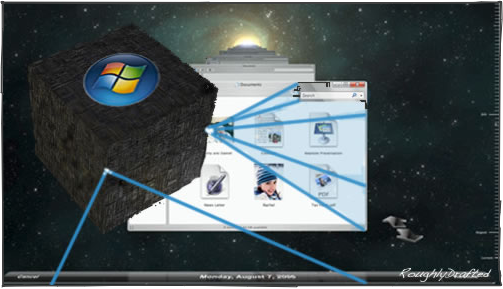





According to proponents of this myth, Apple's new Time Machine is blatant rip off of Microsoft's Volume Shadow Copy, and by extension, nothing in Leopard is interesting at all because it's all been done before. They're wrong, here's why.
Why the Myth was Woven
This myth sprung fully formed from the mind of Paul Thurrott, in his attack on the WWDC announcements about Leopard. Sometimes writers make mistakes, or spin a subject in a way that is technically not precisely correct. In this case, Thurrott went beyond making an inaccurate slip, and dove right into Ann Coulterism. 

He's serving up Kool Aid that is poisoning the Internet in an effort to create a propaganda army of followers ready to repeat anything he says. Even worse, he's distracting from any smart, interesting discussion on tech subjects to spout politically charged advocacy instead.
How to Lie with Facts
In the case of The Time Machine Rip-off Myth, Thurrott was attempting to distract attention away from Apple's Leopard announcements. As the proprietor of a website called Windows SuperSite, he could naturally be expected to advocate Microsoft's products. That's his job.
When you are aware of someone's position, you can evaluate their bias. Knowing Thurrott likes Windows doesn't mean his opinion in other matters is worthless, but it helps in understanding the motivation behind the comments he makes. However, things get slippery when people pretend to be something they are not.
Thurrott plays up a fantasy of impartiality. He says he uses Macs and PCs, and makes comments about how much he likes interoperability. This suggests that the things he says can be taken as face value, as if he is an unbiased reviewer of technology. Unfortunately that's not the case.
He can talk all he wants about about how he owns Macs and how he uses iTunes or loves the iPod, but everything he writes is carefully slanted to misrepresent facts and stir up pointless, bullshit controversy that does nothing but contaminate productive discussions about the merits of a technology. No amount of his complaining about Vista serves to balance that out.
Thurrott isn't contributing an interesting take on the importance or value of Apple's announcements, but rather just doing a simple smear job that pulls various tricks from the fundamentalist extremists who use the radio and web to stir up ignorant, religio-nationalistic jingoism. Here's how it works:
Thurrott Coulterism
Coulterism #1: establish that you are smarter than everyone else by worrying about how your feeble minded audience is in danger of being mislead by an outside Evil.
Thurrott: "Time Machine will fool people that don't know any better"
Is the world at grave risk that Apple is pulling a huge deception in unveiling a new, animated way to visualize file restoration? I don't think so.
Coulterism #2: instill fear, uncertainty, and doubt in a voice suggesting sincere concern.
Thurrott: "Compared to how Tiger was rolled out, this is scary. There's only ten months left. Not a single exciting new feature at the announcement?"
Oh no! Thurrott might end up having to use Vista after all. Bet he's really bummed about that.
Coulterism #3: pretend to give a compliment, then yank it back.
Thurrott: "Leopard could very well be excellent. I hope it is. But there's absolutely no evidence of that now, and this is precisely when Apple should have been making its argument for people to avoid Vista and make the switch. This was a retreat, not an attack."
Actually, the evidence of Leopard's excellence is pretty clear from the reaction of developers actually at WWDC. People are already avoiding Vista because it's not for sale yet.
Coulterism #4: repeat the lie you are trying to instill over and over until the audience will be comfortable parroting it.
Thurrott: "I'm suddenly scared there's no meat there. Seriously, this is alarming."
He’s been repeating ad naseum the idea that Apple over announced, under delivered, ripped off ideas, and will be shipping late. What's next, is he going to complain they've pulled out the core features and that it won't run on users' existing hardware? It's like he can't think of anything to say, so he's repeating what everyone's saying about Vista.
Coulterism #5: concede a point to look balanced, then bundle facts together and dismiss them all without any reasoning.
Thurrott: "The other Leopard features Apple announced [apart from Time Machine and Spaces], alas, are almost all a complete waste of time. They're the types of things one might expect of a minor, interim update, or from free Web downloads. They are certainly not major features as Jobs claimed."
Never mind that you contradicted yourself by previously conceding that other features were "good stuff" and "important enough to be a top feature." Just pretend you've made a point, then use it to make broad, sweeping generalizations. You've already established how fair and balanced you are, so now you have the political capital to spend. Start a war!
Mr. Thurrott: please stop making the world dumber. I have plenty of myths to unravel without you spinning new ones.
What is Time Machine? Apple presented it a solution for Mac users, allowing them to run through backups to retrieve files, photos, contacts on their own, without needing to understand how to write a search query or navigate a backup program.
Apple has a standalone Backup program that works a lot like most existing backup programs. Part of the problem with their Backup is that it’s tied to a .Mac account, and is a download, not an integral part of Mac OS X. Windows XP includes a revised version of the NT Backup that Microsoft has included with Windows for a very long time. Nobody uses either one, but at least in Windows, it is available.
Thurrott could have made a valid point about Apple's belatedly delivering backup functionality that has been around in Windows for some time. In addition to Backup, I've written about several other ideas Apple should copy from Windows:
Instead, Thurrott just attacks Apple's improvements over existing backup solutions. That in itself demonstrates he isn't a interested in encouraging progressive discussion to push both Apple and Microsoft to deliver new innovation, but is really just trying to infect the web with a bitter virus.
I've seen a lot of flack cast upon Longhorn and Vista regarding their excessive, vaporous hype; the loss of promised features; things just not working right; and poorly implemented rip-offs of the look of Tiger, but I haven't yet seen any Mac fanatics panning good advances or features in Vista just out of spite. Apple made no suggestion that they were inventing backups, so Thurrott's heavy handed attack is just ridiculous.
Backing up and restoring files obviously isn't new; innovations frequently improve upon things that aren’t. As reader John Davis pointed out, “James Watt invented the steam engine, but he didn't invent steam, the boiler, fire, or the fact that water expands when heated.” In the same respect, Time Machine delivers some very new things.
The first new thing about Time Machine is its simple visualization that makes restoration something users can do themselves. I've run backup services for all kinds of systems; one of the biggest problems for backup system administrators is having to perform restorations for the user.
The interface for restoring files from backup is complex and potentially dangerous, if users don't understand where they are directing their set of restored files.
Users also have to be experts in understanding where their missing data might be. Windows XP exposed backup shadow copies in the Explorer Previous Versions view. That's good for standalone files, but does nothing for users trying to restore data if they don't know where the file is. In the case of restoring contacts or photo albums, the data they are restoring isn't even a file, it's a component of a file.
A user with a backup of their iPhotos wouldn't be ready to go after restoring a copy of their iPhoto Library; they'd still need to parse through the directories looking for what they saved, which versions were newer, and struggle with merging the two.
That's the second entirely new thing Time Machine does: track data for users in a non-file centric model. The demonstrated search through Address Book, using search results, is very much a new and interesting feature. It works like people think, not as system administrators plan. Do Windows users even know that Outlook has stored their personal folder of contacts in:
C:/Documents and Settings/username/Local Settings/Application Data/Microsoft/Outlook/user.pst?
Good luck finding that and restoring it using Volume Shadow Copy: that file path is invisible by default!
A third new feature of Time Machine is that it delivers a system wide service that developers can hook into to optimize backups, so that backups only involve the real information users might want to recover. That is a key new thing: VCS just backs up a volume or set of directories without regard for how much of the data would be useful to actually archive. Developers have no mechanism to tell Windows not to back up their scratch files.
More Nails in the Coffin
A fourth new idea in Time Machine is not even a backup feature. Time Machine is a demonstration of two new things Apple added to Leopard: Core Animation, and a new way to allow users to leave the desktop in the style of Front Row. This unlocks a lot of new applications for jumping out of the desktop.
People have been chatting up the idea of creating new visualizations of the desktop as a 3D workspace for years, saying the old windows and file icons need to be replaced with something new, but undefined. Well, it looks like their futurist pontificating was wrong. Perhaps a consistent desktop metaphor is fine, and we'll just have occasional needs to jump out and then safely return back.
So Time Machine flies far beyond a server backup tool. Apple has delivered a new way to think about using Macs. Front Row demonstrated the initial idea, and now Time Machine is demonstrating how to use this new capacity to make even normal and boring tasks easier and more visually intuitive.
If Thurrott thinks that all these new ideas are somehow the same as Window's pedestrian volume image duplication utility, what else is in his Kool Aid?
This Series

| | Comment Preview
 Read more about:
Read more about:

 Send |
Send |

 Subscribe |
Subscribe |
 Del.icio.us |
Del.icio.us |
 Digg |
Digg |
 Furl |
Furl |
 Reddit |
Reddit |
 Technorati
Technorati
Click one of the links above to display related articles on this page.
The Time Machine Rip-Off Myth
Saturday, August 12, 2006





Ad










